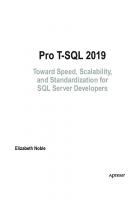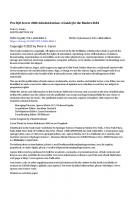Pro T-SQL 2022: Toward Speed, Scalability, and Standardization for SQL Server Developers [2 ed.] 9781484292563, 9781484292556
Learn how to write and design simple and efficient T-SQL code. This is a hands-on book that teaches you how to write bet
720 162 20MB
English Pages 555 Year 2023
Table of contents :
Chapter 1: Data Types
Number Data Types
Exact Number Data Types
Approximate Number Data Types
Converting Number Data Types
String Data Types
Character String Data Types
Unicode String Data Types
Binary String Data Types
Collation for Data Types
Date and Time Data Types
DATE
TIME
SMALLDATETIME, DATETIME, DATETIME2, and DATETIMEOFFSET
Other Data Types
UNIQUEIDENTIFIER
XML
Spatial Geometry Types
Spatial Geography Types
SQL_VARIANT
ROWVERSION
HIERARCHYID
Table
Cursor
Chapter 2: Database Objects
Views
User-Defined Views
Indexed View
Functions
Scalar Functions
Table-Valued Functions
Other User-Defined Objects
User-Defined Table Types
Table-Valued Parameters
Common Table Expressions
Temporary Objects
Temporary Tables
Table Variables
Temporary Stored Procedures
Triggers
Logon Triggers
Data Definition Language Triggers
Data Manipulation Language Triggers
Cursors
Forward-Only Cursors
Static Cursors
Keyset Cursors
Dynamic Cursors
Chapter 3: Standardizing T-SQL
Formatting T-SQL
Naming T-SQL
Commenting T-SQL
Chapter 4: Designing T-SQL
Using Stored Procedures
Using Parameters
Using Complex Logic
Chapter 5: Set-Based Design
Introducing Set-Based Design
Understanding Data Retrieval
Thinking in Data Sets
Identifying Data Sets
Using Data Sets
Writing Code for Data Sets
Chapter 6: Hardware Usage
Considering Memory with T-SQL Design
Considering Storage with T-SQL Design
Considering CPU with T-SQL Design
Chapter 7: Execution Plans
Introducing Execution Plans
Reading Execution Plans
Index Usage in Execution Plans
Logical Join Types in Execution Plans
Chapter 8: Optimizing Databases for T-SQL
Using Query Store
Optimizing Logical Reads
Optimizing Duration
Optimizing Indexes
Automatic Database Tuning
Automatic Plan Correction
Automatic Index Management
Intelligent Query Processing
Memory Grant Feedback
Batch Mode on Rowstore
Adaptive Joins
Chapter 9: Coding Standards
Why Use Coding Standards
What to Include in Coding Standards
T-SQL Design
T-SQL Performance
T-SQL Usability
Chapter 10: Source Control
Reasons to Use Source Control
How to Use Source Control
Rollback Changes
Setting Up Source Control
Chapter 11: Testing
Unit Testing
Integration Testing
Load Testing
Static Code Analysis
Chapter 12: Deployment
Methodology
Types of Deployment
Styles of Development
Feature Flags
Automated Deployment
Chapter 13: Functionality
Inserting and Updating Data
Disable Functionality
Supporting Legacy Code
Reporting on Transactional Data
Dynamic SQL
Chapter 14: Logging
Data Modification
Error Handling
Chapter 15: Enhancement
Adding New Functionality
Application Rules
Feature Flags
Phasing Out Old Technology
Chapter 16: Managing Data Growth
Partitioning
Partition Foundation
Partitioned Tables
Partitioned Views
Hybrid Workloads
Chapter 17: Managing Data Long-Term
Data Retention and Archival
Switching Partitions
Sliding Window Partition
Chapter 18: Implementing Security Features
Data Discovery and Classification
Data Discovery and Classification in SQL Server
Data Discovery and Classification in Azure
Dynamic Data Masking
Row-Level Security
Ledger
Chapter 19: Implementing Encryption
Always Encrypted
Transparent Data Encryption
Index
Chapter 1: Data Types
Number Data Types
Exact Number Data Types
Approximate Number Data Types
Converting Number Data Types
String Data Types
Character String Data Types
Unicode String Data Types
Binary String Data Types
Collation for Data Types
Date and Time Data Types
DATE
TIME
SMALLDATETIME, DATETIME, DATETIME2, and DATETIMEOFFSET
Other Data Types
UNIQUEIDENTIFIER
XML
Spatial Geometry Types
Spatial Geography Types
SQL_VARIANT
ROWVERSION
HIERARCHYID
Table
Cursor
Chapter 2: Database Objects
Views
User-Defined Views
Indexed View
Functions
Scalar Functions
Table-Valued Functions
Other User-Defined Objects
User-Defined Table Types
Table-Valued Parameters
Common Table Expressions
Temporary Objects
Temporary Tables
Table Variables
Temporary Stored Procedures
Triggers
Logon Triggers
Data Definition Language Triggers
Data Manipulation Language Triggers
Cursors
Forward-Only Cursors
Static Cursors
Keyset Cursors
Dynamic Cursors
Chapter 3: Standardizing T-SQL
Formatting T-SQL
Naming T-SQL
Commenting T-SQL
Chapter 4: Designing T-SQL
Using Stored Procedures
Using Parameters
Using Complex Logic
Chapter 5: Set-Based Design
Introducing Set-Based Design
Understanding Data Retrieval
Thinking in Data Sets
Identifying Data Sets
Using Data Sets
Writing Code for Data Sets
Chapter 6: Hardware Usage
Considering Memory with T-SQL Design
Considering Storage with T-SQL Design
Considering CPU with T-SQL Design
Chapter 7: Execution Plans
Introducing Execution Plans
Reading Execution Plans
Index Usage in Execution Plans
Logical Join Types in Execution Plans
Chapter 8: Optimizing Databases for T-SQL
Using Query Store
Optimizing Logical Reads
Optimizing Duration
Optimizing Indexes
Automatic Database Tuning
Automatic Plan Correction
Automatic Index Management
Intelligent Query Processing
Memory Grant Feedback
Batch Mode on Rowstore
Adaptive Joins
Chapter 9: Coding Standards
Why Use Coding Standards
What to Include in Coding Standards
T-SQL Design
T-SQL Performance
T-SQL Usability
Chapter 10: Source Control
Reasons to Use Source Control
How to Use Source Control
Rollback Changes
Setting Up Source Control
Chapter 11: Testing
Unit Testing
Integration Testing
Load Testing
Static Code Analysis
Chapter 12: Deployment
Methodology
Types of Deployment
Styles of Development
Feature Flags
Automated Deployment
Chapter 13: Functionality
Inserting and Updating Data
Disable Functionality
Supporting Legacy Code
Reporting on Transactional Data
Dynamic SQL
Chapter 14: Logging
Data Modification
Error Handling
Chapter 15: Enhancement
Adding New Functionality
Application Rules
Feature Flags
Phasing Out Old Technology
Chapter 16: Managing Data Growth
Partitioning
Partition Foundation
Partitioned Tables
Partitioned Views
Hybrid Workloads
Chapter 17: Managing Data Long-Term
Data Retention and Archival
Switching Partitions
Sliding Window Partition
Chapter 18: Implementing Security Features
Data Discovery and Classification
Data Discovery and Classification in SQL Server
Data Discovery and Classification in Azure
Dynamic Data Masking
Row-Level Security
Ledger
Chapter 19: Implementing Encryption
Always Encrypted
Transparent Data Encryption
Index
![Pro T-SQL 2022: Toward Speed, Scalability, and Standardization for SQL Server Developers [2 ed.]
9781484292563, 9781484292556](https://ebin.pub/img/200x200/pro-t-sql-2022-toward-speed-scalability-and-standardization-for-sql-server-developers-2nbsped-9781484292563-9781484292556.jpg)
- Author / Uploaded
- Elizabeth Noble
![Pro T-SQL 2022: Toward Speed, Scalability, and Standardization for SQL Server Developers [2 ed.]
1484292553, 9781484292556](https://ebin.pub/img/200x200/pro-t-sql-2022-toward-speed-scalability-and-standardization-for-sql-server-developers-2nbsped-1484292553-9781484292556.jpg)

![Pro SQL Server Relational Database Design and Implementation: Best Practices for Scalability and Performance [6th ed.]
9781484264966, 9781484264973](https://ebin.pub/img/200x200/pro-sql-server-relational-database-design-and-implementation-best-practices-for-scalability-and-performance-6th-ed-9781484264966-9781484264973.jpg)
![Murach's SQL Server 2019 for Developers [1 ed.]
9781943872572](https://ebin.pub/img/200x200/murachs-sql-server-2019-for-developers-1nbsped-9781943872572.jpg)





